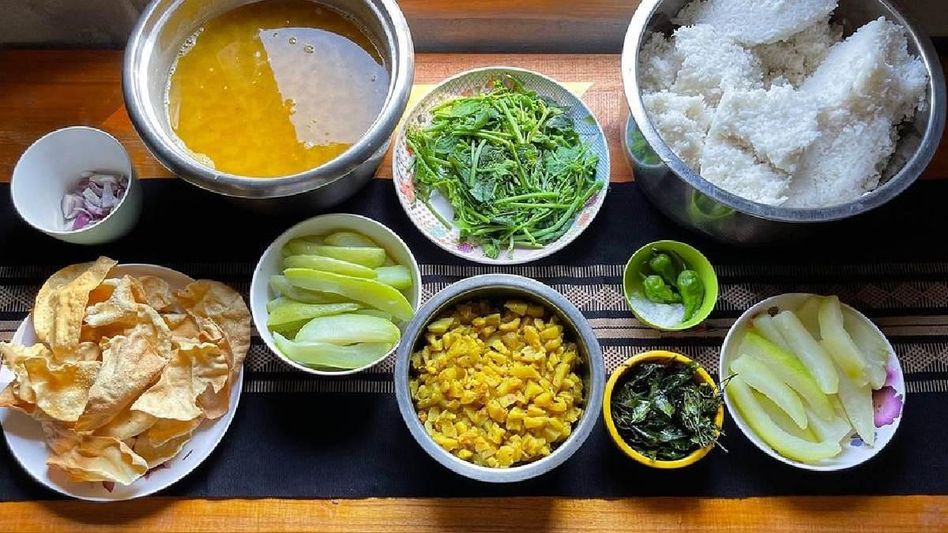
How Naga culinary delights enchant the palates of Guwahati
The Northeast is known for its diverse cuisine, but Naga food stands out for its simplicity. Naga food is known for its spiciness, which is attributed to the diverse range of chilies available in Nagaland
 How Naga culinary delights enchant the palates of Guwahati
How Naga culinary delights enchant the palates of Guwahati“For a wholesome meal, Naga dishes are my go-to comfort food. Mostly boiled and vegetable-based, Naga dishes are devoid of artificial colors or masalas”, says Aarti Dutta, a frequent explorer of Naga restaurants in the city.
According to Ruchika Das, a city-based lawyer and part-time homemaker, the flavors of Naga food are understated yet refined, with a delicate balance of herby and earthy aromas. Furthermore, she adds “ Once every month I and my kids end up at the city’s most loved ethnic restaurant, relishing our regular Naga steamed pork with bamboo shoot.”
The Northeast is known for its diverse cuisine, but Naga food stands out for its simplicity. Naga food is known for its spiciness, which is attributed to the diverse range of chilies available in Nagaland. The most notable among them are Naga Morich and Bhut Jolokia. That being said, the unpretentious Naga food is not as spicy as it is often assumed by those from the North.
Naga food has definitely come to be one of the most loved cuisines among the people of Guwahati. A host of ethnic Naga restaurants have sprung up in the city in recent times which cater to the people’s love for Naga cuisine.
Chef Lugsrang, the head chef of a famous Naga chain restaurant located at the heart of the city, emphasizes that Naga cuisine is light, with a focus on minimal oil and ingredients, to keep your heart and gut healthy. In most recipes, meat and/or vegetables are prepared by steaming, roasting, or boiling to retain their inherent taste.
Dry bamboo shoots and a pork dish are one of the most celebrated Nagaland food items. Nagas savor the pork much like in Thailand or Korea. Don't expect small strips of pork, they use large pieces of the animal to cook. It's common for the pork to be fatty, and you'll often find big chunks of pork belly in the mix. Naga restaurants around the city too, are a pork lover's paradise, offering authentic Naga food that will leave you feeling satisfied.
The absence of various herbs would deprive Naga cuisine of its unique identity. Some unique ingredients that can be used in dishes include culantro or Mexican coriander, which adds a bold flavor to any recipe. While some may not appreciate the subtle flavors of these aromatic herbs, in Naga cuisine, they are essential to achieving the perfect taste. Below are some popular Naga dishes that Chef Lugsrang says one should definitely not miss when in the city if not in Nagaland itself:

Beans Mix: “ Our typical Naga bean mix includes beans, tomatoes, peas, cabbage, and all sort of other natural Nagaland ingredients. Not strong in flavor, but more of a garnish for rice and intended to be eaten with other stronger chili sauces and curries,” says the Chef. “Customers often prefer beans mixed with steamed rice, mostly for dinner and we also customize this dish as per their demands.”, adds Lugsrang.

King chilli chutney: “Made with raja mircha aka king chilli and tomato, this is a boiled version and not roasted version. Raja mircha chutney is a die for condiment and a very popular chutney in Nagaland as well as at our place”, informs Chef Lungsrang.

Akibiye: Nagaland's prized possession, the colocasia root (or arbi), is the hero ingredient of the easy-to-make delicacy, which also adds to the dish's piquancy. The absence of spices in this regional cuisine creates a minimalistic approach to flavor, allowing the thick-curry texture to showcase the dish. As per Chef Lungsrang, a steaming bowl of rice is the perfect accompaniment to Akibiye.

Smoked Pork in Akhuni: An integral part of many tribal communities, akhuni or fermented soybean is known for its distinctive flavour and smell. Boiled, fermented, packed in banana leaves and smoked over the kitchen fire for several days, the process lends a strong umami flavour to the beans. With pork the preferred meat in Nagaland, the dish becomes all the more special. Another popular combination is the dried river fish with akhuni. “This happens to be our most sold dish,” informs the Chef.

Galho: As a native dish, Chef Lugsrang asserts that Galho is a delicious blend of fermented soybeans and smoked beef or pork that can be made vegetarian or with meat. It is a delectable dish comprising rice, veggies, and different meats that was first crafted by the Angami Naga tribe and is now cherished by Guwahati locals.

Steamed fish with bamboo shoot: “Preparing this dish is a breeze, with just bamboo shoots and steamed fish required. The main ingredients are red-dried chilies, fresh fish, garlic, bamboo shoot squeeze, and salt.”, explains the Chef, disentangling the dish.
Furthermore, he tells that, unlike the traditional method of steaming, this dish is not prepared in ordinary utensils. We instead cook it with steam inside a bamboo steamer. As a result, the dish is replete with an unassuming and genuine bamboo taste.
When it comes to food, while ingredients are universal, their pairing and combination is what truly counts. With its diverse selection of meats, fermented foods, fish, bamboo shoot, chillies and even arachnids, Naga cuisine is a true feast for the senses. The burgeoning popularity of Naga cuisine in Guwahati is attributed to its distinctive flavors, wide array of dishes, and successful incorporation of Naga recipes into the Indian taste profile. The city's cosmopolitanism is further enriched by the addition of Naga cuisine to our already diverse
food culture.
Copyright©2025 Living Media India Limited. For reprint rights: Syndications Today









